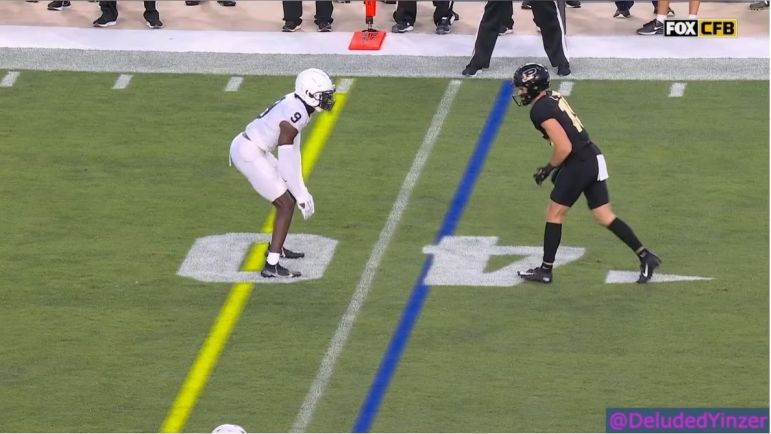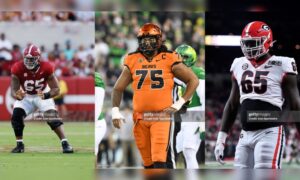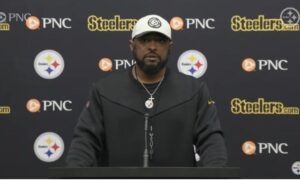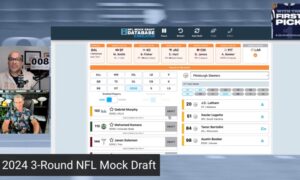When I finished my pre-draft rankings at the cornerback position, I had Penn State’s Joey Porter Jr. ranked as my fourth-best prospect, with his otherworldly length and physical play style as major plus factors. With height (6024), arm length (34”), wingspan (80 7/8”), and hand size (10”) all in the 95th percentile or above for the position, his unique frame is enough to garner the attention of scouts in its own right.
Although nearly everyone in the draft community views Joey Porter Jr. as a corner best suited to play in man-heavy scheme, I came away impressed with his ability to bait and jump routes from zone coverage. Particularly when used as a flat defender in Cover 2 schemes, his length and physicality allow him to eliminate receivers with powerful re-routes. Ultimately, after watching five full games of tape, I came away extremely impressed with Porter Jr.’s ability as an open-field tackler, where he plays with great technique and uses every bit of his frame to punish ball carriers at the point of contact.
Regardless, that will be the topic of another film room. Today, we are here to settle on an evaluation of the strengths and weaknesses of Porter Jr.’s approach in press coverage. Overall, Porter Jr. still has plenty of room to improve in terms of his footwork at the line, where he will still occasionally false step and widen his base. Likewise, he has a bad tendency to shoot his outside hand in press coverage, a habit which hinders his ability to flip his hips and transition to carry downfield.
All that being said, his length allows him to land his punch routinely in the release phase and suffocate receivers on quick game routes and when working in the red zone. While his long speed isn’t world-class, it is more than good enough for him to carry and squeeze receivers into the sideline downfield. He rarely allows vertical separation despite his aggressive approach at the line.
We open things up looking into some red zone work from his 2021 season. In the red zone, where receivers have limited space to work and cannot threaten him vertically, Porter Jr. can at the catch point. On the first rep below, Porter Jr. is caught off guard pre-snap in a free play scenario, standing tall and failing to get into a proper stance in time for the snap.
Despite being caught off guard and off balance, Porter Jr.’s length allows him to connect on a jam and stay close to the receiver’s upfield shoulder with relative ease. As he gets chest to chest to contest any back shoulder balls, Porter Jr. is able to turn, locate the football, and use his Alien-like limbs to swat the pass away with ease.
On the next rep, also from his 2021 season against Auburn, Porter Jr. is far more prepared for the snap, staying square and engaging a powerful off-hand jam to force a wide release. After cutting off the upfield shoulder to protect against the fade, he is able to get chest to chest, locate the football, and play through the receiver to swat away a well-thrown back shoulder ball. Simply put, when playing from in phase, Porter Jr. is able to contest the catch point better than most, particularly when playing from the top shoulder.
In general, Porter Jr.’s ability to clamp down on slant routes from press coverage is in a class of its own among prospects in this year’s draft. All three of these reps, from a road matchup against Purdue this past season, showcase his ability to suffocate receivers at the catch point on quick-game concepts. Overall, he does a nice job of protecting his pre-snap leverage while tasked with preventing an inside release in all three reps below.
On the first rep, Porter Jr. aligns head up on the receiver, staying square at the snap before using his length to engulf the upfield shoulder and play the pocket with both hands. He is ultimately able to secure the pass breakup on a well-thrown ball despite being sealed off and boxed out at the catch point by the receiver. His length alone forces receivers to release short of their intended landmark, as he can land his jam from further out than most other corners. Porter Jr. uses this to his full advantage, rarely giving ground in his press coverage approach, rather choosing to stay patient and allow his frame to force wide releases.
On the next rep, Porter Jr. once again plays from a head up alignment, this time false stepping and allowing separation on the initial release. Despite ceding early separation, Porter Jr. does a great job to track the near hip, close to the catch point, and extend his off arm to secure yet another pass breakup. While he will need to continue refining his footwork and patience at the line, Porter Jr.’s length allows him to close and get back into phase with relative ease in the shallow and intermediate areas of the field.
On the final rep, Porter Jr. aligns with slight inside leverage, once again staying patient at the line with a slight false step before getting his inside arm into the receiver’s chest and squeezing the top shoulder. Once again, despite being boxed out at the catch point, Porter Jr. is able to utilize his arm length to secure an impressive pass breakup. What I particularly love about the current state of his game in press coverage is that he was extremely productive at the college level despite having plenty of room to grow. With further refinement of his footwork and hand usage, Porter Jr. has the potential to develop into a dominant press-coverage player down the line.
As I had mentioned earlier, Porter Jr. rarely allows vertical separation. This is in large part due to him favoring playing from the top shoulder as opposed to the low shoulder. While some corners are more comfortable playing from the low shoulder, Porter Jr.’s length allows him to squeeze and eliminate routes from the top shoulder, while simultaneously protecting against the deep ball.
Here, playing from inside leverage late in the game, Porter Jr. stays patient, forcing a wide release despite a slight false step. As the receiver declares outside, Porter Jr. cuts him off with a strong two-hand jam, sealing off the upfield shoulder, getting chest to chest, looking through the receiver to locate the football, and stepping in front of the pass to nearly secure an interception.
The next step for him is converting some of these high-level pass breakups into takeaways. While his takeaway production doesn’t jump off the screen, an evaluation of his film shows that he created plenty of takeaway opportunities, more often than not failing to complete the catch. Thus, I am of the belief that his turnover production could improve at the next level, particularly playing in a Pittsburgh Steelers defense that is routinely able to force pressured, inaccurate throws with their formidable sub-package, pass rush-oriented packages.
Speaking of those false steps, they routinely show up on tape and, in my opinion, will be the hardest adjustment for him while transitioning to the next level. I would not be surprised if he has a tougher time in training camp matchups against Diontae Johnson than George Pickens. Twitchy route runners can take advantage of his false steps by varying their release package at the line.
Here, playing from inside leverage, Porter Jr. falls for the single stick release at the line of scrimmage, biting on a head fake and taking a hard false step to the outside. This leaves him well out of phase to contest the inside release. While further refinement of his eye discipline and patience will help erase this issue, it will undoubtedly be a process. He needs to understand that if he is able to consistently stay square, his God-given length will allow him to easily match releases in a way that few players can.
The other major issue that I identified centers around his inability to play as effectively from the low shoulder as he does from the top shoulder. While he does a good job of keeping himself out of these positions more often than not, any corner will inevitably need to play from the low shoulder on multiple reps a game.
Here, playing against Ohio State this past season, Porter Jr. does a phenomenal job in the release phase, forcing a wide release, engaging the off-hand jam, and squeezing the receiver into the sideline. This is where the problems arise. Rather than continuing to squeeze and key the receiver’s eyes, he looks back prematurely, allowing the receiver to drift and create separation at the top of the route. That leaves Porter Jr. uncomfortable and forces him to tug on the arm to prevent further separation.
Generally speaking, he tends to panic a bit from out of phase and doesn’t have the natural ball skills to consistently lean, locate, and high point the football. Similar to his false steps at the line of scrimmage, I believe that NFL coaching and more reps can help ease this out of his game. That being said, I don’t think he will ever develop into a corner who plays effectively and poised from a low shoulder position. That being said, few corners dominate from both the upfield and low shoulder positions. Those who do are perennial All-Pros.
Overall, I am extremely encouraged with where Porter Jr. is currently at in terms of his approach to press coverage. While he is by no means a finished product in that area, he has plenty of tools that should allow him to continue to develop and improve with solid coaching from Mike Tomlin, Teryl Austin, and Grady Brown. Next, I will look into his work in off-man and zone coverage, where I think he is a far better player than most members of the draft community give him credit for.








